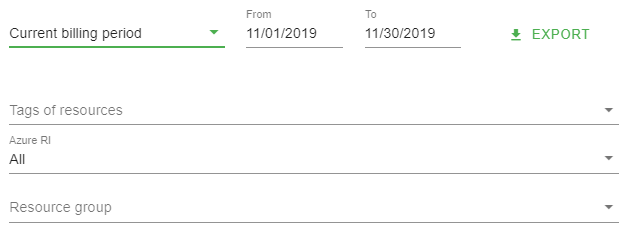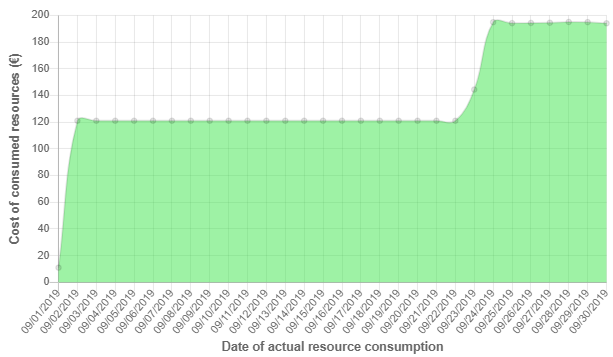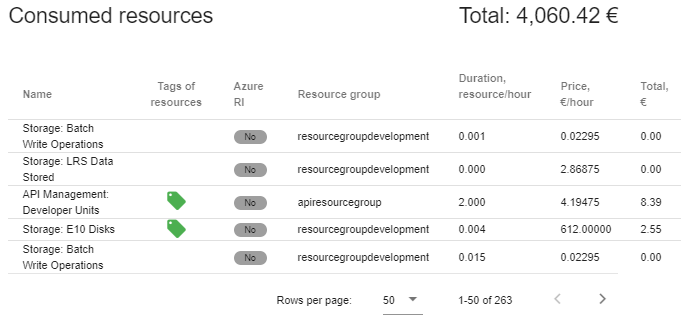Microsoft Azure. "Statistic" section
In this article:
Viewing the Statistic section
Information about consumed resources is displayed in the language that is set in the Application template (see Creation of the Microsoft Azure Application template based on the Office365 plugin) and may differ from the language of the Customer Control Panel.
To view the Statistics section:
- Sign in to the Customer Control Panel. Depending on the access level of the current user, the list of Subscriptions (see List of subscriptions) or the list of Applications (see Работа со списком Услуг) is displayed.
- Hover the mouse pointer over the Microsoft Azure Entry Point. The button is displayed in the lower right corner of the Entry Point.
- Click . The Entry Point menu is displayed.
- On the Entry Point menu, click Statistic. The Statistic page is displayed.
The Statistic page includes the following elements:- The information message about specifics of displaying data due to the potential difference between the date of using a resource and the date of processing by the platform.
- Filters for selecting the resources consumption data to display:
- Billing period — filtering the statistic by the billing date — the date when the platform processed the consumption record (UTC+3 timezone):
- Current billing period — statistic processed by the platform within the current Billing period.
- Previous billing period — statistic processed by the platform within the previous Billing period.
- Previous 3 billing periods — statistic processed by the platform within the previous 3 Billing periods.
- Previous 6 billing periods — statistic processed by the platform within the previous 6 Billing periods.
- Previous 12 billing periods — statistic processed by the platform within the previous 12 Billing periods.
- Custom billing period — statistic processed by the platform within the specified custom period.
- From — prefilled with the start date of the period selected in the Billing period filter. If a custom value is entered, the Custom billing period is selected automatically.
- To — prefilled with the end date of the period selected in the Billing period filter. If a custom value is entered, the Custom billing period is selected automatically.
- Tags of resources — filtering the statistic by the tags of resources in Microsoft Azure. The field supports full-text search by tag names. The list of tag names is sorted in alphabetical order.
- Azure RI — filtering the statistic by the reserved type of resources:
- All — displaying all data.
- Yes — displaying data only for the resources reserved within the Microsoft Azure RI service.
- No — displaying data only for the resources not reserved within the Microsoft Azure RI service.
The displayed statistic is updated automatically. - Billing period — filtering the statistic by the billing date — the date when the platform processed the consumption record (UTC+3 timezone):
- Export — download the information about consumed resources as a report.
To download a report:- Click Export.
- In the appeared menu, select the preferred file format:
- Microsoft Excel (.XLSX)
- CSV
The file in the selected format is downloaded automatically. The report contains data from the Statistic page with the applied filters.
The graph of the daily consumption statistic for the selected period of the billing date against the usage date.
To view the cost of consumed resources for a certain day, hover the mouse pointer over the corresponding dot on the graph, The tooltip with the date and cost is displayed.
The table with the resource consumption costs for the selected period of the billing date. The table includes the following columns:
- Name — resource name.
- Tags of resources — the tags of a resource in Microsoft Azure. If any tags are specified for a resource, the icon is displayed. To view the list of tags for a resource, hover the mouse pointer over the icon.
- Resource Group — resource group name.
- Duration, resource-hour — total number of hours the resource was used.
- Price — resource price per hour.
- Discount — discount amount for the selected period. Not displayed if the discount is not applied.
Total — total cost of the resource.
To sort the rows in the table, click the title of the corresponding column.
- The information message about specifics of displaying data due to the potential difference between the date of using a resource and the date of processing by the platform.
Consumption of Microsoft Azure resources with the included quantity
The Microsoft Azure service may offer the included quantity of a resource that can be consumed for free every Billing period. The quantity of such a resource consumed above the included must be paid by a customer on a common basis.
While processing the consumption statistics received from Microsoft, the platform checks whether the included quantity is offered for a resource. If the included quantity for the resource is greater than 0, for the consumed quantity within the included limit, the cost is set equal to 0. If the consumed quantity exceeds the included limit, the platform generates two records: one record is for the part within the limit of the included quantity and uses the cost equal to 0, and another record is for the part that is greater than the included limit and uses the cost calculated on a common basis. Further consumption of the resource until the end of the Billing period is charged on a common basis. In the Consumed resources table, the resource consumption records within the included limit are displayed as follows: Price = 0, Total = 0.
Consumption of resources from third-party marketplaces
Any information received from Microsoft about consumption of third-party resources that are not included in the Microsoft price list is ignored by the platform and not displayed.







